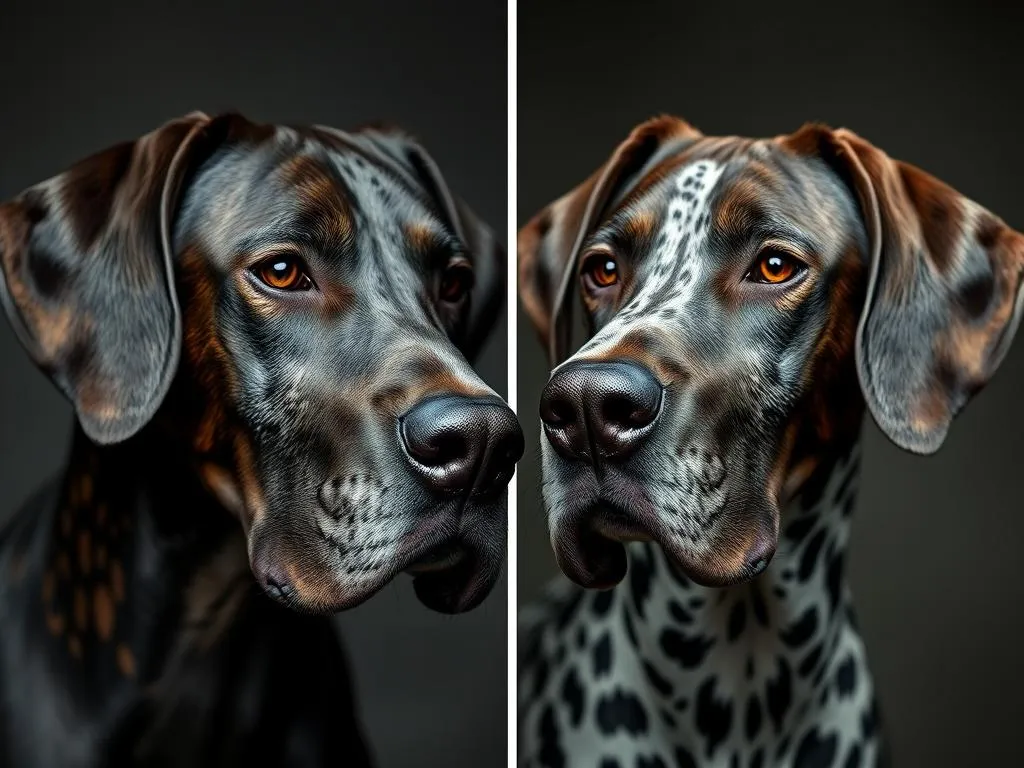
Introduction
Great Danes are often referred to as “gentle giants” due to their impressive size and friendly demeanor. This breed is known for its loyalty, affection, and protective nature. As a potential Great Dane owner, understanding the differences between male vs female Great Danes is crucial in making an informed decision for your family and living situation.
Overview of Great Danes
History of the Breed
The Great Dane’s origins can be traced back to ancient times. They were bred in Germany, primarily for hunting large game such as wild boar. Over time, they evolved into a breed recognized for its companionship and guarding abilities. The American Kennel Club (AKC) officially recognized the Great Dane in 1887, and since then, they have become a beloved breed around the world.
Characteristics of Great Danes
Great Danes are known for their striking appearance. They typically stand between 28 to 34 inches tall at the shoulder and can weigh between 100 to 175 pounds. Their coat comes in various colors, including fawn, brindle, blue, black, and harlequin. Beyond their physical attributes, Great Danes are celebrated for their friendly and affectionate temperament, making them excellent family pets.
Male Great Danes
Physical Characteristics
Male Great Danes are generally larger and more muscular than their female counterparts. An average male stands between 30 to 34 inches tall and weighs around 140 to 175 pounds. They have a broad chest, large head, and a strong, sturdy build that contributes to their impressive stature.
Temperament and Behavior
In terms of personality, male Great Danes often exhibit a protective nature. They tend to be more assertive and may display dominant behaviors, especially if not properly trained. However, they are also highly affectionate and enjoy being around their families. Males are generally more playful and can be more rambunctious, making supervision important when interacting with children and other pets.
Health Considerations
Male Great Danes can be prone to certain health issues, including hip dysplasia, bloat, and heart problems. Their lifespan averages 7 to 10 years, which is typical for large breeds. Regular vet check-ups and a balanced diet are crucial for maintaining their health.
Training and Socialization
Training a male Great Dane requires consistency and patience. They respond well to positive reinforcement techniques. Early socialization is vital to prevent any aggressive tendencies and to help them become well-adjusted adults. Introducing them to various environments, people, and other animals will aid in their development.
Female Great Danes
Physical Characteristics
Female Great Danes are typically smaller than males, standing between 28 to 32 inches and weighing between 100 to 140 pounds. They often have a more slender build, with a narrower head and slightly more refined features compared to males.
Temperament and Behavior
Female Great Danes are generally perceived as nurturing and often exhibit a gentler demeanor. They can be less aggressive than males and are usually more sensitive to their owners’ emotions. Females tend to bond deeply with their families and are often protective, especially around children. Their calm nature makes them great companions in a family setting.
Health Considerations
Similar to males, female Great Danes are susceptible to health issues such as hip dysplasia and bloat. However, females may have a longer lifespan, averaging around 8 to 12 years. Proper diet, exercise, and regular veterinary care are essential for maintaining their health.
Training and Socialization
Training female Great Danes can be easier than training males due to their generally calmer demeanor. They are receptive to training and often excel in obedience classes. Like males, socialization is crucial, but females may adapt more readily to new environments and situations. Consistent training, along with positive reinforcement, will help them thrive.
Key Differences Between Male and Female Great Danes
Size and Build
When comparing the physical attributes of male vs female Great Danes, the difference in size is the most noticeable factor. Males are larger and more muscular, while females are more slender and agile. This size difference can impact living situations; larger males may require more space and a sturdy environment, while females can adapt to smaller spaces.
Personality Traits
Male Great Danes are often more assertive and protective, while females tend to exhibit gentler and nurturing behaviors. This difference can significantly affect how each gender interacts with children and other pets. Males might show more playfulness, while females may display a calm demeanor, making them more suitable for quieter households.
Training Differences
Training male Great Danes can pose challenges due to their stubbornness and dominant tendencies. In contrast, females usually respond better to training, making them easier to manage. Adapting training methods to suit each gender’s unique personality traits can lead to better results, ensuring a well-behaved companion regardless of gender.
Health and Longevity
Both male and female Great Danes face similar health concerns; however, females tend to have a slightly longer lifespan. Understanding these health differences can help owners prepare for potential medical needs and make informed decisions regarding preventive care.
Choosing Between a Male and Female Great Dane
Factors to Consider
When deciding between a male and female Great Dane, consider your lifestyle and living environment. Active families may benefit from the playful nature of males, while those seeking a calmer companion might prefer females. Additionally, assess your living space; if you have limited room, a female may be more suitable.
Personal Preferences
Personal experiences with dogs can heavily influence your choice. Some owners may prefer the playful nature of males, while others might favor the nurturing characteristics of females. Evaluating individual temperament and behavior is essential, as both genders can be wonderful companions when matched with the right environment.
Recommendations for Potential Owners
When choosing between a male vs female Great Dane, take into account your family dynamics, activity levels, and space. Visit local shelters or breed-specific clubs to meet dogs of both genders and gauge which one resonates with you. Resources such as dog training classes can also provide insights into each gender’s behavior and training responsiveness.
Conclusion
Understanding the differences between male and female Great Danes is vital for potential dog owners. While both genders have their unique traits, they are equally capable of providing love, loyalty, and companionship. Whether you prefer the assertiveness of a male or the gentleness of a female, choosing the right Great Dane for your family will lead to a rewarding relationship. Always consider adopting from a shelter or rescue, as responsible ownership begins with giving a dog a loving home.









